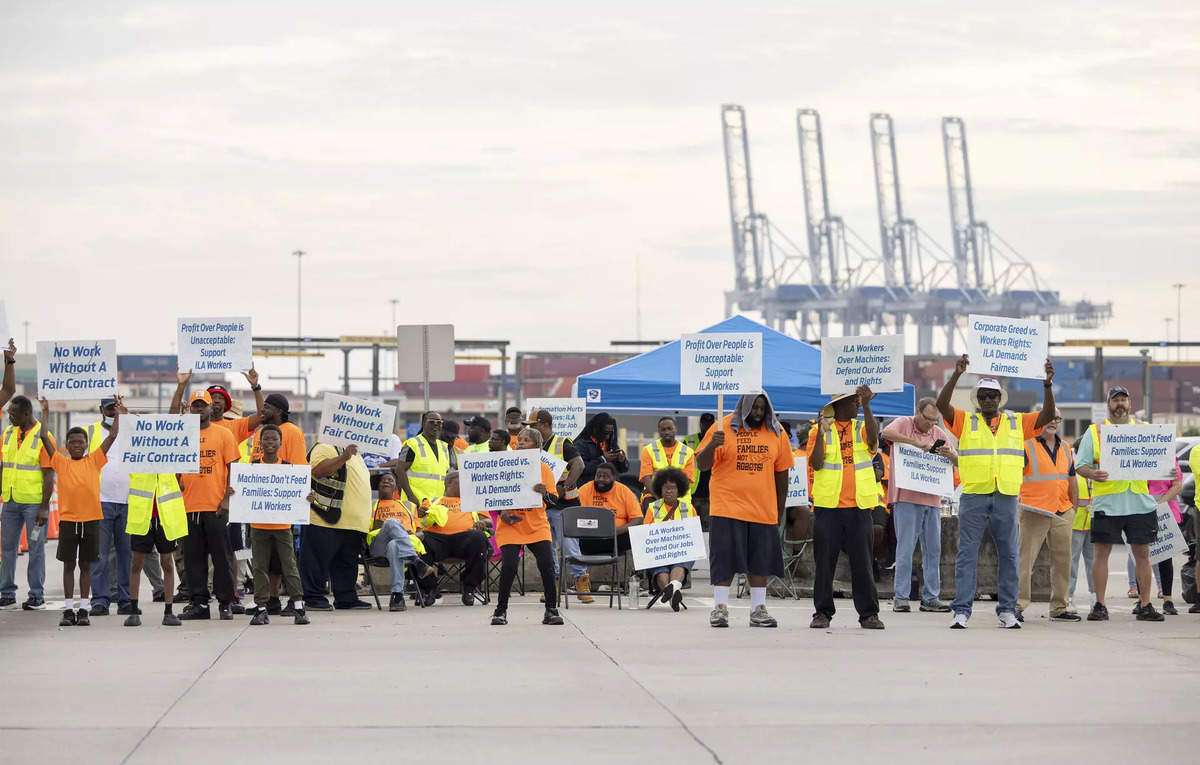Infra
US port union agrees to suspend strike – ET Infra

The International Longshoremen’s Association agreed Thursday to suspend a strike that closed down major ports on the East and Gulf coasts. The move followed an improved wage offer from port employers.
The strike, which the dockworkers union began Tuesday, threatened to weigh on the economy five weeks before national elections. Employers, represented by the U.S. Maritime Alliance, have offered to increase wages by 62% over the course of a new six-year contract, according to a person familiar with negotiations who did not want to be identified because the talks were continuing. That increase is lower than what the union had initially asked for but much higher than the alliance’s earlier offer.
In a statement, the union said that it had reached “a tentative agreement on wages” and that its 45,000 members would go back to work, with the current contract extended until Jan. 15. The union said it was returning to the bargaining table “to negotiate all other outstanding issues.” The alliance issued a similar statement.
The agreement came after the White House pressed both sides to reach a deal to end the strike, the union’s first full-scale walkout since 1977. The wage increase is a clear victory for the ILA and its combative president, Harold J. Daggett, a 78-year-old, third-generation dockworker who has led the union since 2011.
President Joe Biden, when asked about the tentative deal on the tarmac at Joint Base Andrews on Thursday evening, said: “We’ve been working hard on it. With the grace of God, it’s going to hold.”
A 62% increase would raise the top longshoremen’s wage to just over $63 per hour at the end of a new six-year contract, from today’s $39 per hour. And at $63 an hour, the wages of East and Gulf Coast longshoremen would slightly exceed those that will be earned by West Coast longshoremen, who belong to a different union, at the end of their contract in 2027.
In the resumed talks, the issue of how much automation can occur at the ports could divide the sides. The union has also been pressing for improved retirement benefits.
Another potential sticking point is the pay of longshoremen who are just starting out and don’t earn the top wage rate. Daggett’s son, Dennis A. Daggett, a senior official at the ILA, said in an interview Tuesday on a picket line in Bayonne, New Jersey, that the union wanted to get higher wages for less experienced members.
Many businesses, expecting the strike, accelerated imports through the ports before the strike. But a long strike could have led to shortages, and it was already beginning to cause congestion in supply chains.
Perishable goods were particularly at risk from a strike. “I’m definitely relieved,” Daniel J. Barabino, chief operating officer at Top Banana, a fruit distributor based at the Hunts Point Produce Market in New York City, said after the announcement Thursday. “I’m happy to have this behind us.”
Around three-fifths of annual container trade goes through the East and Gulf Coast ports, including the Port of New York and New Jersey, the third-busiest in the country, and fast-growing ports in Virginia, Georgia and Texas. The West Coast ports, which remained open during the strike, were getting close to capacity and would not have been able to absorb much more cargo diverted from East Coast ports.
The Georgia Ports Authority said its facilities would reopen Friday, and the Port of New York and New Jersey said it would dispatch mechanics Friday morning to get the terminal back to an operational status. On Thursday evening, the Port of Virginia said it would take 24 hours to fully restore operations.
Longshoremen, who load containers and other cargo off ships and onto trucks and trains, in general earn higher wages than workers in other blue-collar jobs.
When moving large amounts of goods in and out of the country, there is no practical alternative to ports. And ports cannot operate without longshoremen, giving them a strong hand in labor negotiations.
By going on strike and closing down the ports, the ILA deployed its leverage to get a higher wage offer from the Maritime Alliance. The employer group offered a raise of around 40% raise over the life of the contract, while the union sought 77%. The alliance then increased its offer to nearly 50%, before both sides agreed to 62%.
As businesses grew more concerned about the economic blow from a strike, they had pressed Biden to use the 1947 Taft-Hartley Act to force the longshoremen back to work. But throughout the dispute, he encouraged the sides to keep talking to reach a deal.
Biden administration officials worked behind the scenes with both sides to try to bring about a resolution in the days and weeks leading to the deal, according to people familiar with the White House’s thinking. That culminated in a flurry of activity Thursday, including a trip by the acting labor secretary, Julie Su, to New Jersey to meet with the union’s leaders to secure their agreement.
Officials ramped up pressure for a deal in recent days by stressing the need to reopen the ports after the devastation caused by Hurricane Helene, these people said. In an early-morning Zoom call with foreign carriers Thursday, officials framed reaching a deal as a patriotic duty to expedite aid.
“Collective bargaining works, and it is critical to building a stronger economy from the middle out and the bottom up,” he said in a statement Thursday.
Critics of the tentative agreement say it will push up costs for importers and exporters.
“I cannot recall an episode that had so little effect on the economy, led to such a short strike and resulted in such a huge increase in earnings for workers who are already making over $100,000 a year,” said Patrick L. Anderson, chief executive of the Anderson Economic Group, a consultancy. “We tend to shrug off the costs, but it does affect our ability to build things and export them.”
At the Port of New York and New Jersey, nearly 60% of the longshoremen made $100,000 to $200,000 in the 12 months through June 2020, the latest figures available, according to data from an agency that helped oversee the port.
But the ILA has asserted that the port employers can afford to pay them more, especially after making outsize profits during the pandemic surge in trade in 2021 and 2022.
The White House cited those profits when pushing the employers to raise their wage offer, said a person familiar with the actions of the Biden administration, who was not authorised to speak publicly about them.





![[!LIVE-FOOTBALL@!]+ Commanders vs Eagles Live Stream ! Atlanta Falcons vs New York Giants LIVE , player stats, standings, fantasy games TV channels and more HS8079 [!LIVE-FOOTBALL@!]+ Commanders vs Eagles Live Stream ! Atlanta Falcons vs New York Giants LIVE , player stats, standings, fantasy games TV channels and more HS8079](https://www.reddotdigitalit.com/wp-content/uploads/2021/05/Streaming-Platform.jpeg)




